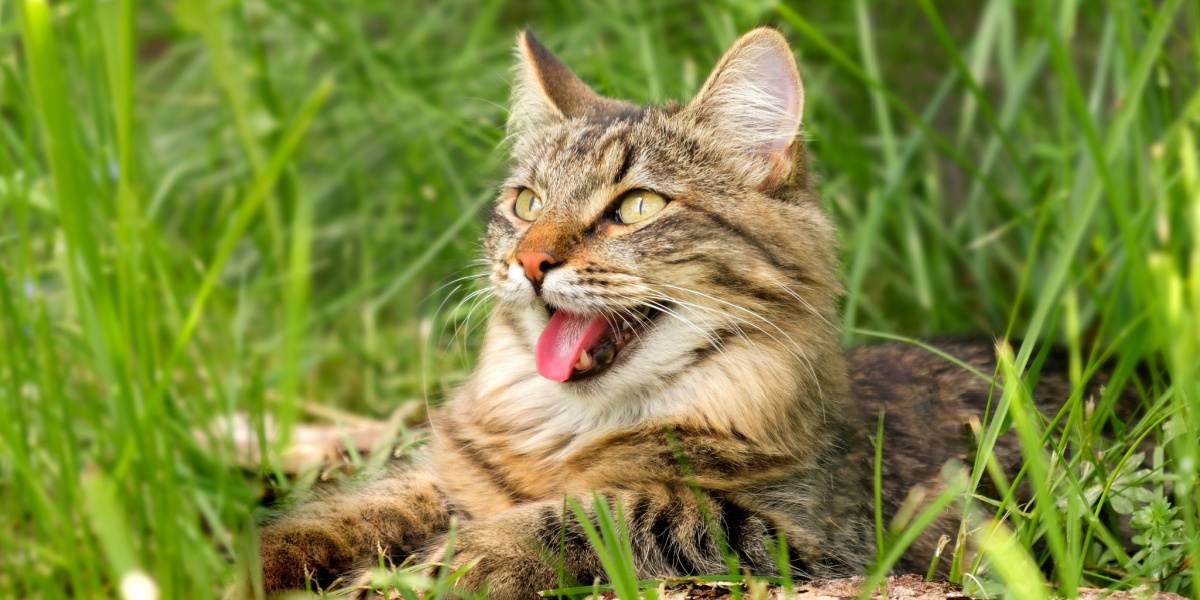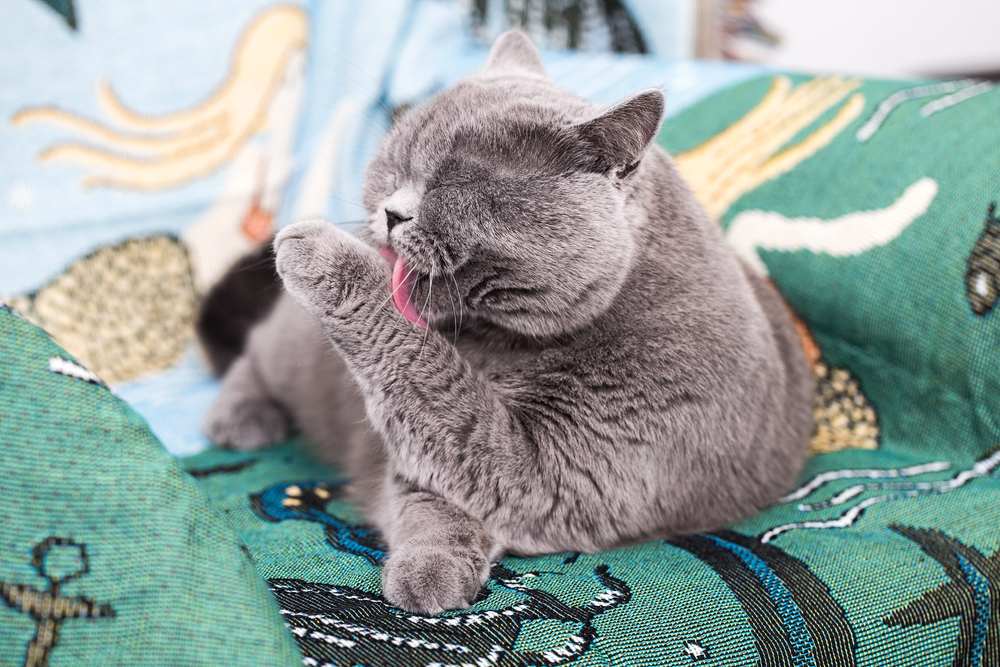
Permethrin toxicosis in cats is a common toxicity that occurs from the accidental or inappropriate use of certain fleas, ticks, and other pest control products on or around cats.
While the effects are severe, there is a very successful recovery rate with prompt and appropriate treatment. In this article, you’ll learn what causes permethrin toxicity, how to recognize signs in your cat, how this toxicosis is treated and prevented, and some frequently asked questions.
Before continuing, if you suspect your cat may have been exposed to a permethrin product, it is best to contact your veterinarian, the ASPCA Animal Poison Control Center (1-888-426-4435), or Pet Poison Helpline (1-855-764-7661) immediately for further advice.
Quick Overview: Disease Summary
 Common Symptoms: Tremors, facial and ear twitching, muscle spasms, uncoordinated movements, seizures.
Common Symptoms: Tremors, facial and ear twitching, muscle spasms, uncoordinated movements, seizures.
 Diagnosis: History of application of a permethrin product coupled with matching signs of illness within 72 hours.
Diagnosis: History of application of a permethrin product coupled with matching signs of illness within 72 hours.
 Diagnosed in Cats: Moderately Often
Diagnosed in Cats: Moderately Often
 Requires Ongoing Medication: No
Requires Ongoing Medication: No
 Vaccine Available: No
Vaccine Available: No
 Treatment Options: If signs of illness have occurred, primary veterinary treatment is aimed at addressing muscle tremors and seizures. Oral detoxification if licking/ingestion is suspected.
Treatment Options: If signs of illness have occurred, primary veterinary treatment is aimed at addressing muscle tremors and seizures. Oral detoxification if licking/ingestion is suspected.
 Home Remedies: If no signs of illness yet, bathe with liquid dish soap to remove any permethrin product from the hair and skin. Avoid the stress of bathing if signs of illness have occurred.
Home Remedies: If no signs of illness yet, bathe with liquid dish soap to remove any permethrin product from the hair and skin. Avoid the stress of bathing if signs of illness have occurred.
What Is Permethrin Toxicosis in Cats?
Pyrethrins are natural chemicals with insecticide properties. They are derived from the chrysanthemum plant, specifically, Chrysanthemum cinerariaefolium.
Because natural pyrethrins are less stable with light exposure, synthetic chemicals with the same properties called pyrethroids were developed. This includes permethrin, flumethrin, deltamethrin, and others.
Pyrethrin insecticides work by disrupting sodium-gated nerve channels in arthropod nerve cells. This leads to paralysis and the death of insect pests like fleas and ticks.
These products are typically very safe to use around many mammals, especially dogs. However, cats differ greatly from dogs in their metabolism. It is this difference that makes these products very toxic to them.
There are two metabolic processes that cats are not very good at. One is called glucuronidation and another is called ester hydrolysis. Both of these are needed for pyrethrins to be safely eliminated by the body, which cats are unable to do.
When cats are exposed to pyrethroid compounds like permethrin either topically on their skin or through ingestion, they commonly develop neurologic signs of toxicity. Symptoms include muscle tremors, seizures, abnormal walking/balance issues, and other effects.
Causes of Permethrin Toxicosis in Cats
There are three main avenues of permethrin toxicosis in cats.
- A flea/tick spot-on product containing a pyrethroid chemical like permethrin (usually a product labeled for dogs and not for cats) is inappropriately applied directly on a cat, either by accident or intentionally (by a cat parent unaware of the dangers).
- A flea/tick product containing permethrin is properly applied to a dog in the household, but through either grooming the dog or close contact, a cat in the home is exposed to the product.
- Any number of other pest control products containing a pyrethroid compound in the form of agricultural sprays or other indoor/outdoor pest control products that are applied in or outside the home and a cat is exposed.
Most topical flea/tick products are obtained over the counter without a prescription. While this makes them accessible and more affordable, many mistakes can occur in their purchase and use, which is dangerous for cats.
Commonly used spot-on products for dogs that contain permethrin include (but are not limited to) Advantix, K9 Advantix II, Vectra 3D for Dogs, and some flea/tick collars for dogs. These are over-the-counter products and many generic forms are also available.
Confusion over very similar products for cats happens because of similar product names and/or packaging. Advantage II for cats may appear similar to Advantix II for dogs. Vectra 3D comes in products for both dogs and cats, but only the dog product contains permethrin while the cat product does not. These details are easily overlooked by pet owners.
Dog products containing permethrin often have percentages exceeding 45%. There are some products approved for cats that contain permethrin but with levels lower than 1%.
Splitting a single dose of a topical product for dogs among multiple pets, including cats is dangerous. Reducing the volume of the product does not reduce the concentration of the drug. If a cat is exposed to even a small amount of permethrin found in a dog product, toxicity is still likely to occur.
Because of the high level of danger that is posed to cats from these products, many veterinarians are of the opinion that their sale should be restricted or they should be available only by prescription.
Steps have been taken in recent years to make product labeling clear, including prominent notifications that a product cannot be used on cats, clear photos of a dog vs. a cat on the product packaging, and other precautions.
However, even despite these changes, inappropriate use still occurs. In a 2020 article in the Israel Journal of Veterinary Medicine titled “Retrospective Evaluation of Factors Associated with the Morbidity and Outcome of Permethrin Toxicosis in Cats,” the authors found that even though Advantix was the most appropriately labeled product with the most cautionary messaging, it was still the product most commonly associated with toxicity.
What About Permethrin-Treated Clothing?
People with a high risk of exposure to mosquitos and ticks may use permethrin-treated clothing as an alternative to applying an insect repellent to their skin or having their yard treated.
A concern is often raised about whether permethrin-treated clothing may be a toxicity risk to cats who come in contact with it. Fortunately, the concern is considerably lower than the risks posed by a cat having contact with a topical dog product or an agricultural insecticide product.
In an interview with NPR, then director of toxicology of the ASPCA Animal Poison Control Center, Dr. Charlotte Means, states that “It’s the dose that makes the poison”.
Topical products for dogs may be as high in permethrin as 45%, while concentrations in household sprays and pre-treated clothing are less than 1%. At concentrations less than 5%, toxicity concerns with cats are rarely seen.
Dr. Means says that while there may always be an individual cat with a higher sensitivity than the general population, “If you are spraying a 1% solution on clothing and it dries, it’s unlikely that you’ll see any problems in the cat.”
So while dog products and agricultural products are a high toxicity risk, there is no evidence showing that treated clothing is a concerning route of exposure for cats.
Signs of Permethrin Toxicosis in Cats

If you observe the symptoms of permethrin toxicosis in your cat, veterinary intervention is essential.
The most commonly reported clinical signs of permethrin toxicosis in cats include tremors, facial and ear twitching, muscle spasms, seizures, and inappropriate walking or incoordination, which is called ataxia.
There are many other symptoms of permethrin poisoning, including drooling/hypersalivation, dilated pupils (mydriasis), elevated body temperature, rapid breathing, and hyperexcitement. Paradoxically, some cats present symptoms of lower body temperature, lethargy, and immobility.
In severe cases without appropriate treatment coma and death are unfortunately possible.
The onset of toxicity signs after permethrin exposure is variable but happen usually within a couple of hours on average. In a Clinician’s Brief article from 2012 entitled “Managing Exposure to Permethrin,” the cat featured in the case study developed signs in only 30 minutes after the application of a permethrin product to the skin. Signs may take as long as 72 hours to appear.
If a cat is suspected to have been exposed to permethrin but is not showing any signs of illness, and proper steps have been taken, still watch the cat closely for at least three days.
Treatment of Permethrin Toxicosis in Cats
Immediate treatment steps to take with permethrin exposure at home depend on whether a cat is showing visible signs of illness or not.
1. Recent Exposure and No Signs of Illness
If a permethrin product was applied topically or if a cat accidentally came in contact with a product on their skin but no signs of illness have yet occurred, thoroughly bathe the affected areas with warm water.
Use plain dish soap, like Dawn dish soap. Because these products are oily, using dish soap is a safe and effective item to use that is readily available.
2. Active Signs of Illness
If a cat is showing signs of illness, especially twitching, tremors, or seizures, there is no at-home treatment that is effective. Veterinary care should be sought immediately. At this point, avoid bathing the cat because the stress of bathing actually worsens the tremors.
There is no specific antidote for permethrin toxicity. Steps taken at a veterinary hospital are symptomatic and aimed at supportive care to treat muscle tremors and/or seizure activity. The affected fur is trimmed and the cat is bathed. Oral detoxification may happen if a significant amount was licked off/ingested.
Inducing vomiting to remove something that was ingested is very challenging in cats and is not always helpful. Never try to induce vomiting yourself at home with hydrogen peroxide. While this sometimes works in dogs, it rarely works in cats and will only contribute to further stress and delay appropriate treatment.
Tremors and seizures are treated with injectable benzodiazepines like diazepam (Valium) or midazolam. More recently, methocarbamol, a muscle relaxer, has been found to be very successful at relieving signs of muscle tremors and is used intravenously as a continuous infusion. Methocarbamol is associated with shorter hospitalization times, a finding supported in the 2020 article from the Israel Journal of Veterinary Medicine, as well as an article from 2022 in Toxics entitled “Treatment of Permethrin Toxicosis in Cats by Intravenous Lipid Emulsion.”
Additional or more potent anticonvulsant medication may be needed if there is more severe seizure activity.
Intravenous fluids also help regulate body temperature, which is often elevated and fluctuates with seizure and muscle tremoring activity.
Very recently, a treatment called intravenous lipid emulsion (ILE) has been used successfully. The Toxics article describes a very recent study where ILE was used in nine cats from a colony in which a permethrin product was inappropriately divided among them. With lipid infusion, muscle tremoring subsided after about 10 minutes. Seven of the cats were discharged in 24 hours. The other two were discharged about a day later.
Overall, the amount of time needed for successful treatment is 24 hours, up to 2-3 days. The cat in the Clinician’s Brief article from 2012 was discharged after only 26 hours. When looking at other treatment methods that excluded ILE and methocarbamol, the Toxics article authors found that the average hospitalization period was about three days.
Treatment periods of up to seven days are common in more severe cases or in cases where prompt treatment was not sought.
Keep the packaging of any recently applied flea/tick product. This will help a poison control center expert or your veterinarian understand which kind of drug exposure has occurred.
How To Prevent Permethrin Toxicosis in Cats
Prevent permethrin toxicosis in cats by being fully aware of the flea/tick products you use in your home. Be aware of any pesticide treatments used in or around the outside of your home.
There are many flea/tick products available. If you have both cats and dogs in your home (as well as fish, who are also very susceptible to permethrins), discuss with your vet what alternative products to use on your dogs to avoid permethrin use in the home entirely.
Here are some other tips to prevent these dangerous toxic exposures in your cat.
- Purchase products for your cat that feature a photo of a cat on the box. If this is not present or clear, look for any warnings against using the product on cats.
- Never use topical products orally in pets. If a product comes as a liquid in a small single-dose vial, it is unlikely that it’s an oral product.
- Never use your dog’s product on your cat, even if the product is for small dogs. Avoid accidentally mixing up the products by keeping them in separate places, like in separate cabinets or drawers.
- Always keep the packaging boxes for any flea/tick products. The vials or tubes inside the boxes often do not have any warning labels on them.
- If you do use a permethrin product on your dog, keep any cats from having contact with the pup for at least 24 hours. Some recommend up to 72 hours for the best safety.
- Generally, do not split topical products for use on multiple pets. Even very small amounts of a dog product may be toxic to cats.
- Always be aware of yard sprays or other chemicals being used in or around your home.
- Always check with your vet if you are uncertain about using a product for your cat.
- While permethrin-treated clothing appears to be safe for cats once dried, follow these additional tips:
- Always double check the percentage concentration of permethrin in the product you’re using. Products less than 5% are a low toxicity risk for cats.
- Keep your cat away from any recently soaked/treated clothing that has not yet dried.
- Keep permethrin-treated clothing away from where your cat sleeps to prevent prolonged exposure.
- Remove permethrin-treated clothing when you come indoors before spending time with your cat.
- If you’re using a permethrin soak to treat your clothing, prevent access to it and don’t allow your cat to ingest it.
Final Thoughts

Be vigilant about using the appropriate pest control products on pets.
Permethrin toxicosis is a common risk in households with both dogs and cats where canine flea/tick products are used. While signs of toxicity like tremors and seizures are scary, prompt veterinary treatment often results in a full recovery. Constant vigilance and consumer awareness are key to preventing permethrin toxicosis in cats.
Also Read: Can Cats Get High From Inhaling Smoke?
Frequently Asked Questions
How long does permethrin toxicity last in cats?
When treated properly, most cats recover within three days. In more severe cases, some cats may require up to seven days of treatment. Unfortunately, without treatment, signs of toxicity often worsen and can lead to coma and death. Do not “wait it out” or hope that signs will pass on their own.
Will my cat survive permethrin poisoning?
There is a high survival rate among cats that are treated promptly and properly after permethrin toxicosis. Without proper and timely treatment, signs often worsen, which can lead to coma and death.
How long does pyrethrin toxicity last in cats?
Although a natural product, pyrethrin is just as toxic to cats as its synthetic cousin, permethrin, and other pyrethroids like it. Just like with permethrin toxicity, pyrethrin toxicity may last about 3 days on average with proper care. Some cats recover sooner, and a few take up to seven days to fully recover. Without proper treatment, a cat may not survive the toxic exposure.
Can cats recover from pyrethrin poisoning?
Yes, cats can make a full recovery from pyrethrin poisoning. While treatment may take a couple of days, prompt and proper veterinary care typically leads to a full recovery with no lasting effects.
If proper veterinary care is not sought or is delayed, effects on the body from continuous muscle tremors and seizures can lead to coma and death. If a cat still recovers, some lasting effects from stresses on the body are possible.







